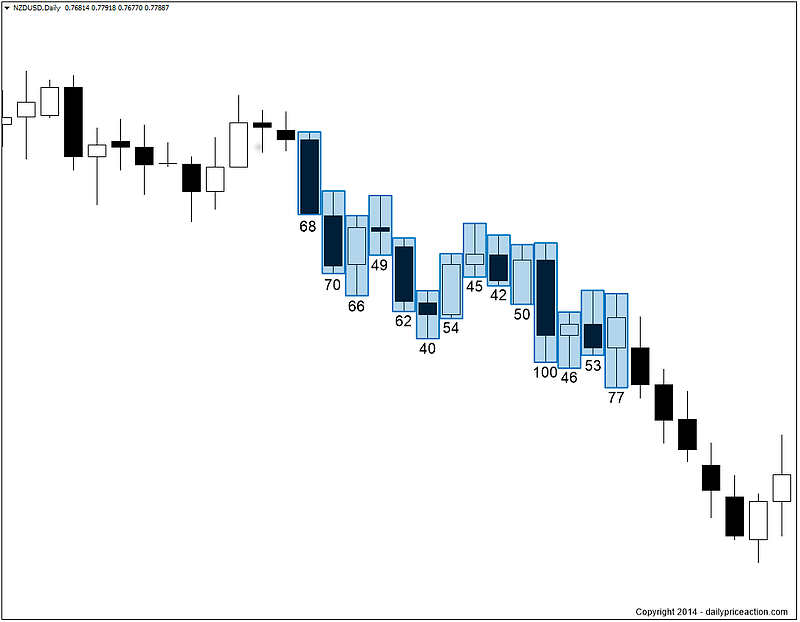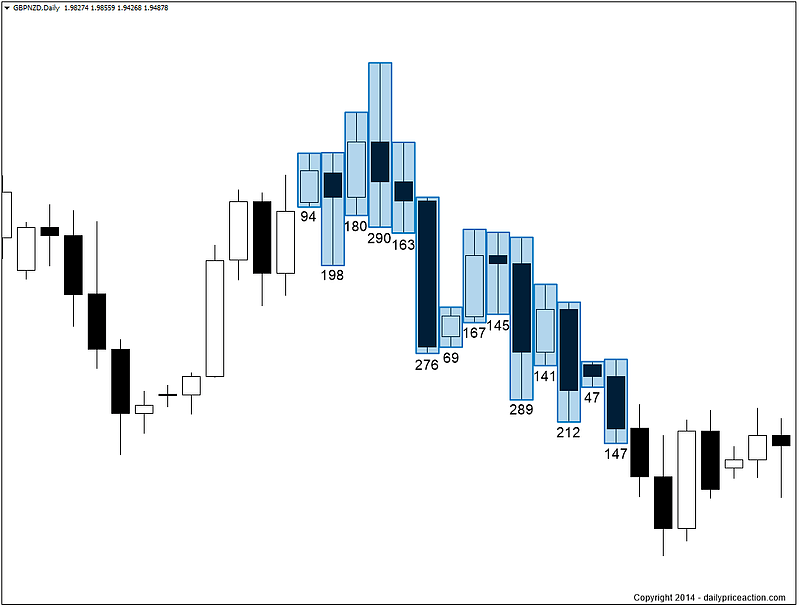Average True Range (ATR) and Average Daily Range (ADR) are two of the most common measurements used by traders in the financial markets. You may know them as the ATR and ADR indicators.
Wait, this is a lesson about an indicator? On Daily Price Action?…
Absolutely not. 😉
This is a lesson about the concept of average range, rather than a specific indicator. We’ll discuss the concept of ADR as well as how we can use it to our advantage when trading the Forex market.
But before we dig in, you have to make me a promise. You have to promise that you will not, under any circumstances, apply the ADR indicator to your charts after reading this post.
Promise?
Okay, let’s move on…
What is Average Daily Range?
There are two schools of thought when it comes to average daily range. The first is to use the actual indicator to calculate the exact average over a specified period of time. However, this is unnecessary when trading simple price action the way I teach it in my Forex course.
Instead, we’re going to focus on the second school of thought, which is the concept of average range – a simpler and much more effective approach.
So what exactly does this concept tell us?
It tells us that every trading instrument in every market has an average distance that it travels each day. This is true for stocks, commodities, futures (etc.) and of course, Forex.
Here’s a look at ADR in action.
The chart above shows the NZDUSD daily time frame. The numbers below each candle represent the number of pips the currency pair traveled each day. In other words, the number of pips between the high and low.
The idea behind the average daily range is that each market has its own “personality” when it comes to how far it travels in a single day.
Take the NZDUSD chart above as an example. A quick glance at the period of time highlighted in blue shows that on a normal day, the pair moves between 40 and 70 pips. Of course, there are anomalies, such as the 100 pip day. However, for the most part, each day ranges between 40 and 70 pips.
Now let’s take a look at a GBPNZD daily chart, a pair which moves a great deal more.
Notice the stark difference between the average range of GBPNZD in the chart above and NZDUSD in the first example. It’s easy to see that GBPNZD has a much larger average range than that of NZDUSD.
What’s the significance of this?
The significance is that each market has a unique range that is likely to be covered on any given day. Imagine if you could predict an approximate high and low for the day.
Would that kind of information help you?
Seems far-fetched, and it is to some degree. But combine a market’s ADR with what I’m about to show you and it becomes extremely advantageous.
How to Use ADR to Your Advantage
Now that you have a solid understanding of how to “read” a market’s average range, it’s time to get into how you can use it to your advantage when trading the Forex market.
Knowing a market’s ADR becomes beneficial when using blind entries.
What is a blind entry, you ask?
A blind entry is an entry that is taken without the need for a price action strategy such as a pin bar or inside bar. It’s typically executed using a limit buy or sell order placed at an area of strong support or resistance.
The illustration below shows how a blind entry can be executed.
Notice how there is no bearish price action that triggers the sell limit order. The close that broke support was so convincing that bearish price action wasn’t necessary to justify a short entry.
But without a price action signal, how would we know that the market isn’t likely to break back above the key level?
Simple, by using the average daily range to help determine which scenario is probable.
That being said, there are no guarantees when trading Forex. The best we can do is construct an environment where the odds are in our favor. And by knowing the average range of this market, we can do just that.
Here’s how…
The GBPAUD daily chart below shows a typical scenario of a bearish engulfing candle breaking a key level.
In most cases, we would want to wait for bearish price action at the former support level before initiating a short position. However, a quick look at the average range of each candle gives us an option for a different approach.
Here’s a closeup of the same bearish engulfing candle, only this time we get an idea of how far this pair likes to move in a single day.
As you can see from the chart above, GBPAUD likes to move about 150 to 200 pips a day on average. This is great information to have when evaluating a potential blind entry.
But this still doesn’t answer the question – how could we have known that a move back above the key level was unlikely? In other words, how could we have known that a blind entry to sell this market was a favorable setup?
Here’s your answer…
Notice in the chart above that the market had moved down to the low of the day before moving back to retest the key level. This is what made a blind entry favorable. The fact that the market would have to move 220 pips just to get back to retest the former support level as new resistance.
Study this chart a few times if you have to as this is the key to using average range to your advantage. Even if the market had made a bullish move of 300 pips that day, which was extremely unlikely, we would have been left with an 80 pip loss (300 – 220). That may sound bad until you factor in the potential reward of 350 pips, giving you a 4.37R trade, or an 8.74% profit if risking 2%.
As we noted above, GBPAUD likes to move between 150 and 200 pips each day. By using the concept of average range, we could easily deduce that a move past the 220 pips necessary to retest the key level was unlikely, thus giving favor to a blind entry.
Final Words
I know this stuff works because I traded the GBPAUD example we just covered. In fact, I typically take about one blind entry each month. They don’t always work out this well, but they are profitable enough to have remained a part of my trading arsenal since 2011.
Initially, I had no intention of selling GBPAUD using a blind entry. However, when I saw the market move down 150 pips to start the week, I knew that it would take everything the pair had to retest the key level as new resistance within 24 hours. This put me in a favorable position to use a sell limit order on a retest as new resistance.
If the market hadn’t triggered my order within the same day, I would have canceled the sell limit order. This is because if I had allowed a new day to start, it would mean a fresh average range for that day, rendering a blind entry unfavorable.
Using a market’s average daily range can greatly improve your ability to discern whether a blind entry is suitable for a particular setup. However just like all things we discuss here at Daily Price Action, using the concept of ADR is only as good as the other confluence factors surrounding a particular setup.
Here are a few things to keep in mind when analyzing a market’s average daily range for use with blind entries.
- Keep it simple – there’s no need to use the ATR or ADR indicators or become concerned with actually calculating the average range
- ADR should always be used in conjunction with a key support or resistance level
- Using average range in combination with blind entries is most favorable in situations where a key level is broken with conviction
- Only use this strategy on the daily time frame in order to mitigate the potential for false breaks
Taking blind entries can be risky without the proper use of average daily range in combination with a key level. I don’t advise it if you’re new to trading price action. In which case you’re much better off sticking with the strategies I teach in my Forex price action course.
However, if you are experienced, the strategy we just covered will make a great addition to your trading toolbox.
Your Turn
We covered a more advanced topic in this lesson on using average range to your advantage, so there are bound to be some questions out there. 😉
Ask them below and I’ll be sure to respond.
Talk soon.









